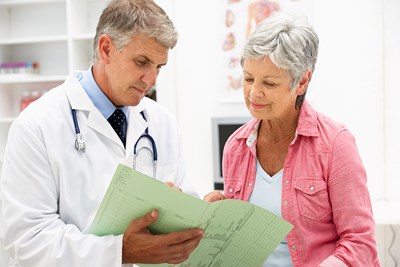Salmonellosis is an infection of the Salmonella bacteria and is one of the most common foodborne illnesses in the U.S. The symptoms of salmonellosis can appear in as little as six hours or as many as 36 hours after infection. The amount of bacteria that actually gets into the gastrointestinal tract plays a role in how quickly you get sick -- as well as how sick you get.
The most common symptoms include diarrhea, abdominal cramping, fever, muscle pains, and headache. This may last as long as a week. Generally, the best thing to do is to simply keep your nutrition up and stay hydrated, while riding out the illness. Taking antidiarrheals can actually make diarrhea go on longer, although it may be less severe. On the other hand, taking antibiotics is generally not recommended for healthy adults, as it can result in an extended duration of carrying the bacteria. Here is a look at who is most at risk for developing salmonellosis.
High-Risk Populations
The exception to the antibiotic rule is in special populations: elderly folks, infants, and those with a compromised immune system. In these, salmonellosis can be fatal and often requires hospitalization. In these instances, doctors often administer antibiotics, as well as intravenous fluids to reduce dehydration.
Disorders that may affect the immune system make you more likely to contract salmonellosis -- particularly as a lesser amount of the bacteria can create an infection more easily. These include HIV/AIDS, sickle cell disease, and malaria. Additionally, certain medications such as corticosteroids or those taken to help reduce the chances of rejection following an organ transplant may increase the risk.
Risk Factors
For these people, salmonellosis is a greater risk than the general public. However, just about everyone is at risk for salmonellosis. It is prevalent in animals, thus it can make it into your kitchen from the supermarket. Having certain pets, such as birds or lizards, can make it more likely that you will contract salmonellosis.
It also travels in feces, so not washing your hands carefully after cleaning animal stool out of your yard, changing a diaper, or going to the bathroom may be more hazardous than gross. Still, developing countries tend to have higher rates of illness, because of the lack of sanitation. Thus, traveling to these areas may increase your risk.
Medication Risks
The reason such a high amount of bacteria is necessary to cause infection is because the stomach acid can actually kill small amounts of bacteria before they stake their claim in the epithelial cells of the stomach. Some inflammatory bowel diseases can make the stomach less able to resist because the lining of the stomach is so damaged. This increases the chances of Salmonella taking hold. Even if you suspect you have plenty of stomach acid because of frequent heartburn, you may be lowering your belly’s ability to fight off Salmonella by taking lots of antacids, since they cut down on stomach acid. Recent or frequent use of antibiotics also destroys the good gut bacteria, making it less able to fight off the bad.



